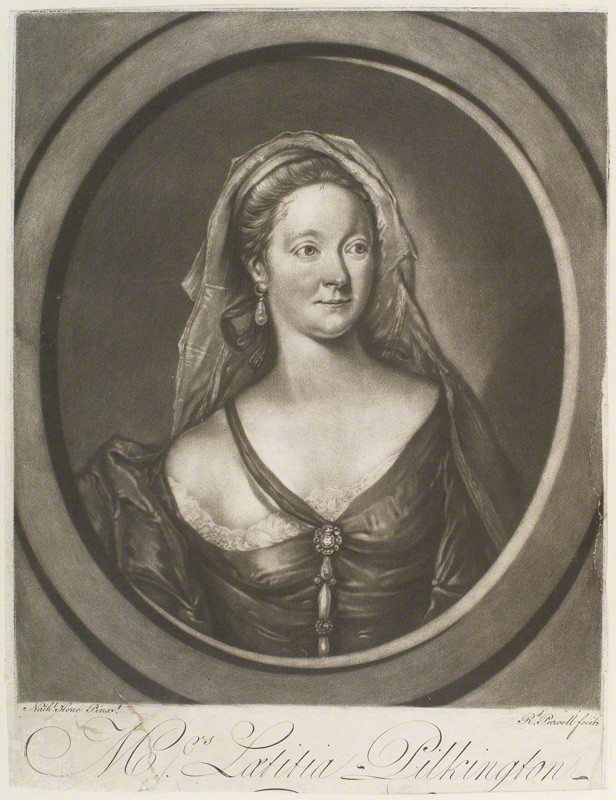Laetitia Pilkington (née van Lewen)
(c. 1709 - 29 August 1750)© National Portrait Gallery, London

Works in ECPA
alphabetical listing / listing in source editions
Source editions
- Barber, Mary, ca. 1690-1757. Poems on Several Occasions [poems only]. London: Printed for C. Rivington, at the Bible and Crown in St. Paul's Church-Yard, 1734. xlviii,283,[7]p.; 8⁰. (ESTC T42622; DMI 519; Foxon p. 45)
- Pilkington, Laetitia, 1712-1750. The statues: or, the trial of constancy. A tale for the ladies. London: printed for T. Cooper, 1739. 18p.; 2⁰. (ESTC T48642; Foxon P279; OTA K045265.000)
- Dodsley, Robert, 1703-1764. A Collection of Poems in Six Volumes. By Several Hands. Vol. V. London: printed by J. Hughs, for R. and J. Dodsley, 1763 [1st ed. 1758]. 6v.: music; 8⁰. (ESTC T131163; OTA K104099.005)
Biographical note
Laetitia Pilkington was the daughter of John van Lewen (1684-1737), a Dublin physician
of Dutch origin, and his wife Elizabeth (d. c. 1742). In 1725 she married clergyman and poet Matthew Pilkington (1701-1774). In about
1729, the couple was introduced to Jonathan Swift, who accepted them into his circle of friends and in 1732 procured Matthew an appointment
in London. After various liaisons, seemingly on both sides, the Pilkingtons separated
in 1738. Laetitia Pilkington eventually settled in London. In 1739, her poem The Statues; or, the Trial of Constancy. A Tale for the Ladies
, was published by Robert Dodsley. In the 1740s, she corresponded with Colley Cibber
and Samuel Richardson who offered her some support. Her Memoirs were published in Dublin in 1748. They contained her collected verse and offered insight
into her dealings with Swift, Cibber, Richardson, and the publisher Edmund Curll.
Her account of Swift's habits and household events during his later years became a
valuable resource for Swift biographers. She died in Dublin on 29 August 1750.
Bibliography
Editions
-
Elias, A. C., Jr, ed. Memoirs of Laetitia Pilkington. Athens; London: Georgia UP, 1997. Print. 2 volumes.
-
Tucker, Bernard. The poetry of Laetitia Pilkington (1712-1750) and Constantia Grierson (1706-1733). Studies in British literature, v. 20. Lewiston: The Edwin Mellen Press, 1996. Print.
Biography
-
Clarke, Norma. Queen of the Wits: A Life of Laetitia Pilkington. London: Faber and Faber, 2008. Print.
Reference works
-
Baines, Paul, Julian Ferraro, Pat Rogers, eds. The Wiley-Blackwell Encyclopedia of Eighteenth-Century Writers and Writing, 1660-1789. Malden, MA: Wiley-Blackwell, 2011. 270. Print.
-
Pilkington, Laetitia
. A Collection of Poems by Several Hands [1782]. Ed. Robert Dodsley and Michael F. Suarez. Vol. I. London: Routledge/Thoemmes, 1997. 191-193. Print. 6 volumes. -
Todd, Janet, ed. A Dictionary of British and American Women Writers 1660-1800. Paperback edition, revised. Lanham et al.: Rowman & Littlefield, 1987. 250-252. Print.
Criticism
-
Backscheider, Paula.
Inverting the image of Swift's 'Triumfeminate'
. Journal for Early Modern Cultural Studies 4(1) (2004): 37-71. Print. -
Gerrard, Christine.
Laetitia Pilkington and the Mnemonic Self
. The Review of English Studies 70(295) (June 2019): 489–508. Print. -
Messenger, Ann, ed. Gender at work: four women writers of the eighteenth century. Detroit, MI: Wayne State UP, 1990. Print.
-
Tucker, Bernard.
Swift's 'Female Senate': Three Forgotten Poets
. Irish Studies Review 7 (1994): 7-10. Print.
![[frontispiece]](/images/authors/colour-portraits/banner-frontispiece.jpg)
![[section of text]](/images/screenshots/ECPA-snippet5.jpg)
![[poet writing]](/images/authors/colour-portraits/banner-poet.jpg)